CHEVROLET AVEO 2002 Service Repair Manual
Manufacturer: CHEVROLET, Model Year: 2002, Model line: AVEO, Model: CHEVROLET AVEO 2002Pages: 5127, PDF Size: 41.82 MB
Page 1471 of 5127
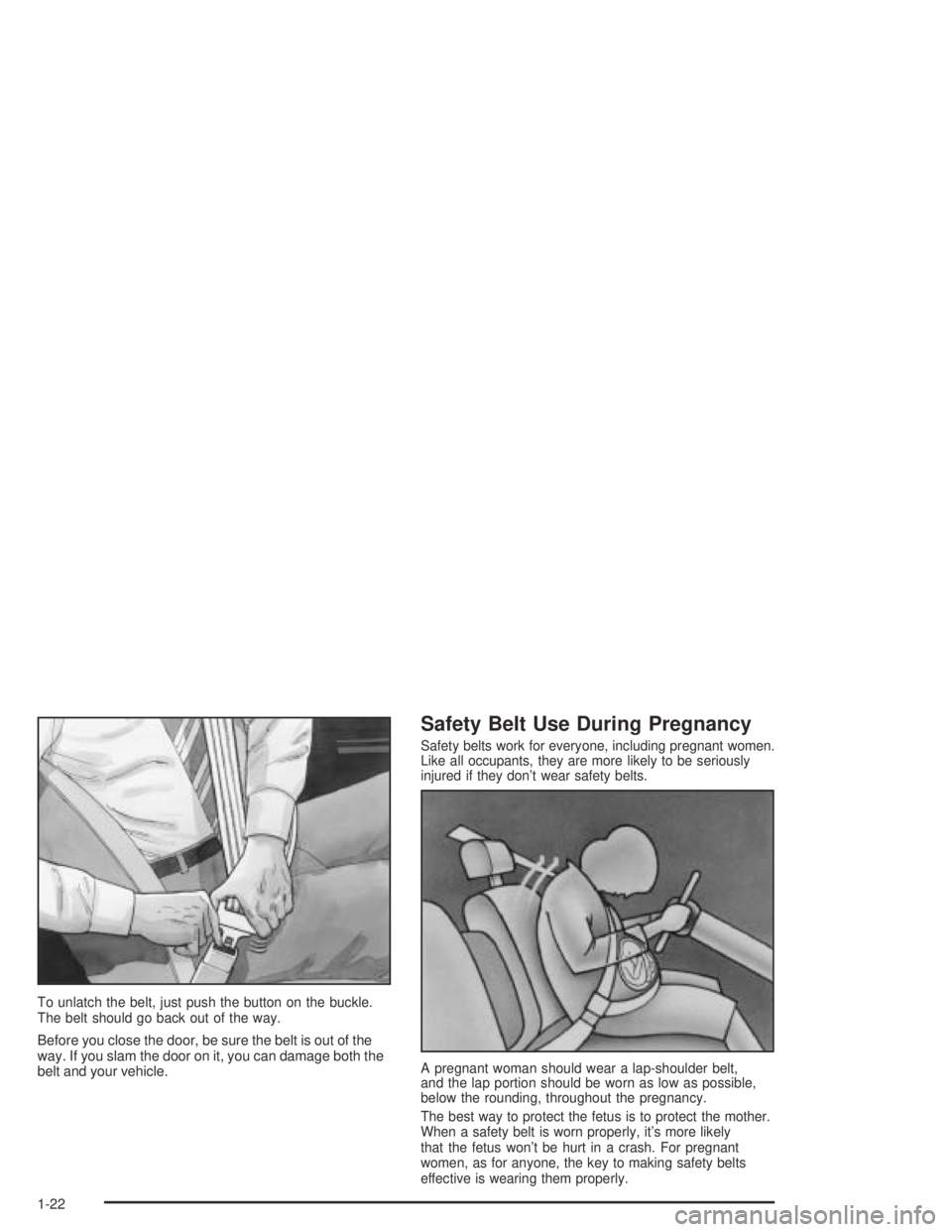
To unlatch the belt, just push the button on the buckle.
The belt should go back out of the way.
Before you close the door, be sure the belt is out of the
way. If you slam the door on it, you can damage both the
belt and your vehicle.
Safety Belt Use During Pregnancy
Safety belts work for everyone, including pregnant women.
Like all occupants, they are more likely to be seriously
injured if they don’t wear safety belts.
A pregnant woman should wear a lap-shoulder belt,
and the lap portion should be worn as low as possible,
below the rounding, throughout the pregnancy.
The best way to protect the fetus is to protect the mother.
When a safety belt is worn properly, it’s more likely
that the fetus won’t be hurt in a crash. For pregnant
women, as for anyone, the key to making safety belts
effective is wearing them properly.
1-22
Page 1472 of 5127
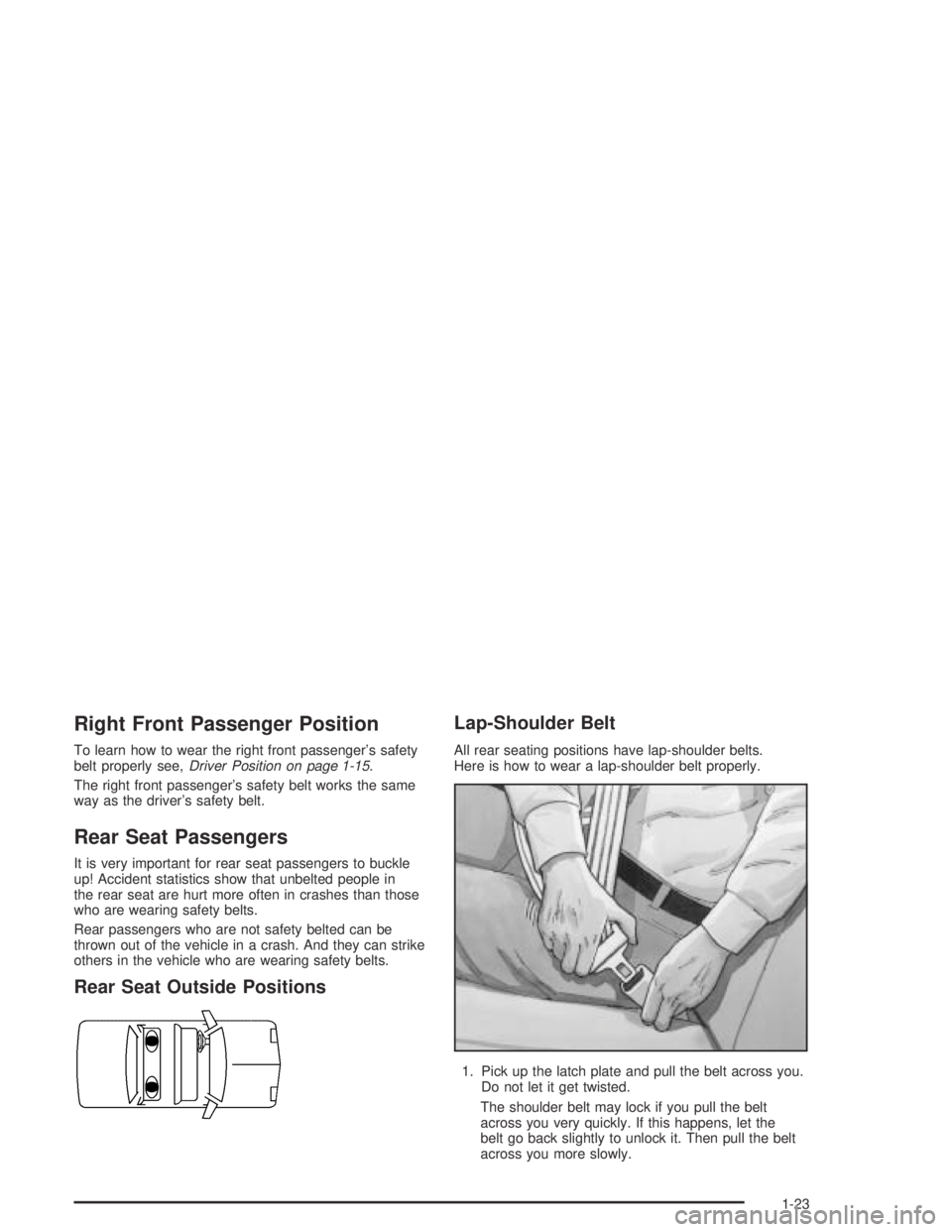
Right Front Passenger Position
To learn how to wear the right front passenger’s safety
belt properly see,Driver Position on page 1-15.
The right front passenger’s safety belt works the same
way as the driver’s safety belt.
Rear Seat Passengers
It is very important for rear seat passengers to buckle
up! Accident statistics show that unbelted people in
the rear seat are hurt more often in crashes than those
who are wearing safety belts.
Rear passengers who are not safety belted can be
thrown out of the vehicle in a crash. And they can strike
others in the vehicle who are wearing safety belts.
Rear Seat Outside PositionsLap-Shoulder Belt
All rear seating positions have lap-shoulder belts.
Here is how to wear a lap-shoulder belt properly.
1. Pick up the latch plate and pull the belt across you.
Do not let it get twisted.
The shoulder belt may lock if you pull the belt
across you very quickly. If this happens, let the
belt go back slightly to unlock it. Then pull the belt
across you more slowly.
1-23
Page 1473 of 5127
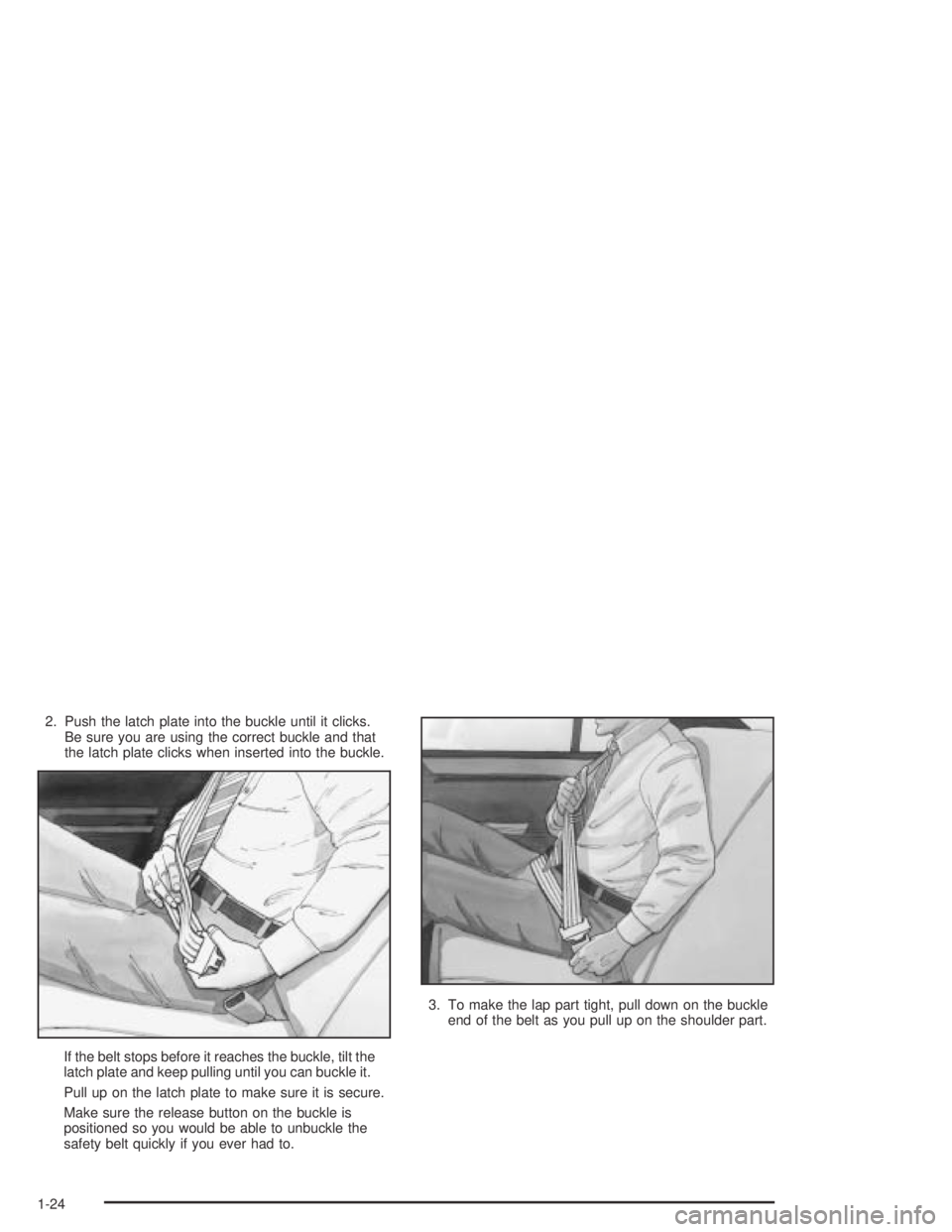
2. Push the latch plate into the buckle until it clicks.
Be sure you are using the correct buckle and that
the latch plate clicks when inserted into the buckle.
If the belt stops before it reaches the buckle, tilt the
latch plate and keep pulling until you can buckle it.
Pull up on the latch plate to make sure it is secure.
Make sure the release button on the buckle is
positioned so you would be able to unbuckle the
safety belt quickly if you ever had to.3. To make the lap part tight, pull down on the buckle
end of the belt as you pull up on the shoulder part.
1-24
Page 1474 of 5127
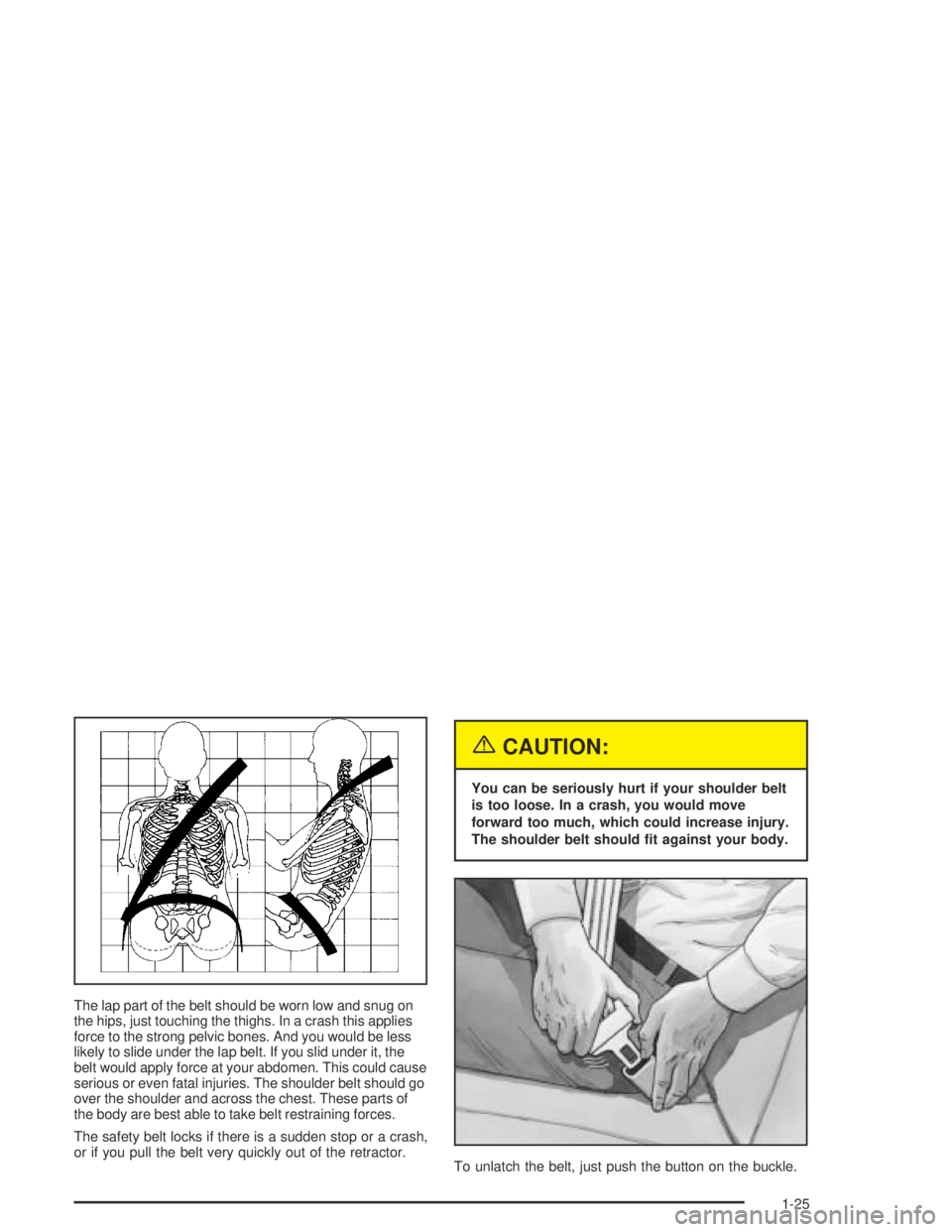
The lap part of the belt should be worn low and snug on
the hips, just touching the thighs. In a crash this applies
force to the strong pelvic bones. And you would be less
likely to slide under the lap belt. If you slid under it, the
belt would apply force at your abdomen. This could cause
serious or even fatal injuries. The shoulder belt should go
over the shoulder and across the chest. These parts of
the body are best able to take belt restraining forces.
The safety belt locks if there is a sudden stop or a crash,
or if you pull the belt very quickly out of the retractor.
{CAUTION:
You can be seriously hurt if your shoulder belt
is too loose. In a crash, you would move
forward too much, which could increase injury.
The shoulder belt should �t against your body.
To unlatch the belt, just push the button on the buckle.
1-25
Page 1475 of 5127
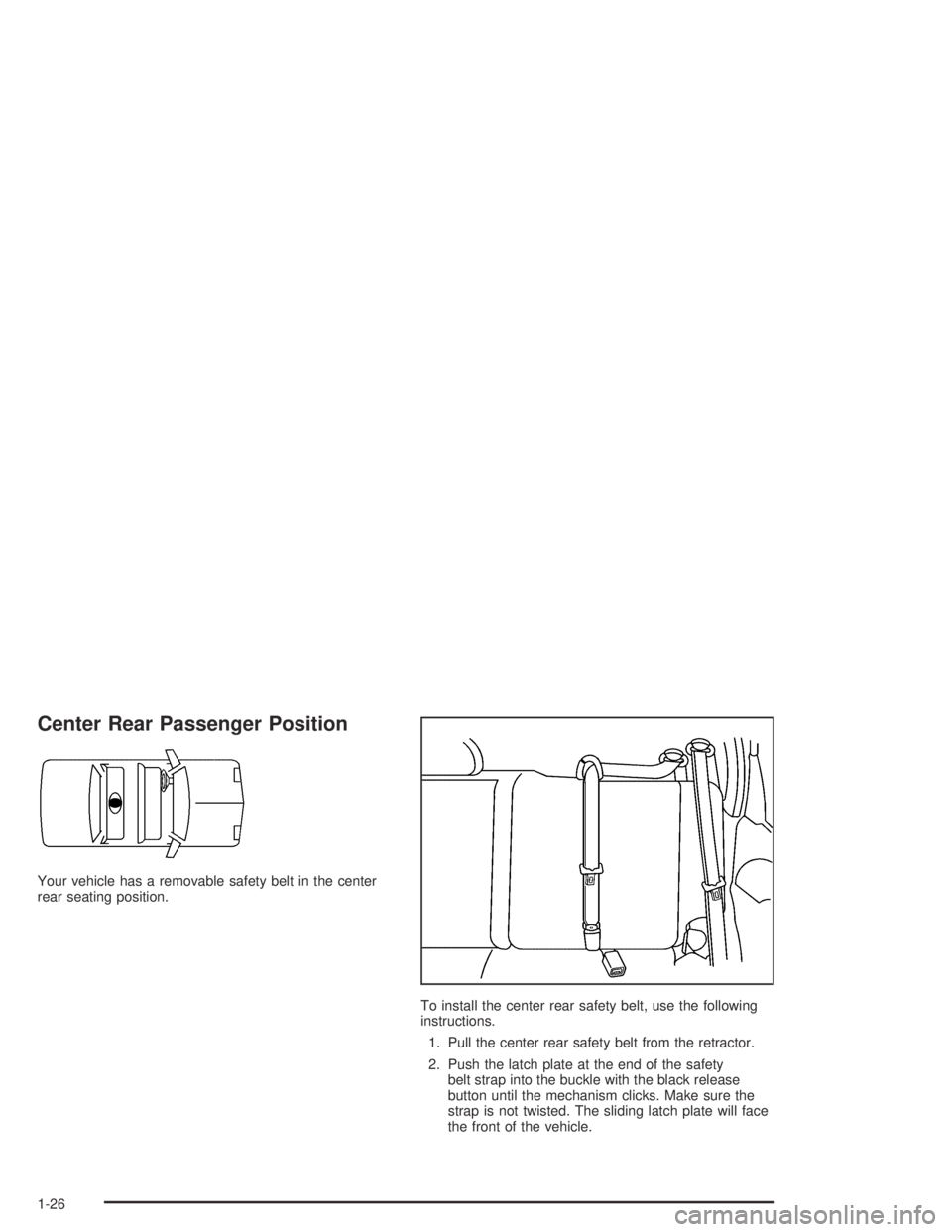
Center Rear Passenger Position
Your vehicle has a removable safety belt in the center
rear seating position.
To install the center rear safety belt, use the following
instructions.
1. Pull the center rear safety belt from the retractor.
2. Push the latch plate at the end of the safety
belt strap into the buckle with the black release
button until the mechanism clicks. Make sure the
strap is not twisted. The sliding latch plate will face
the front of the vehicle.
1-26
Page 1476 of 5127
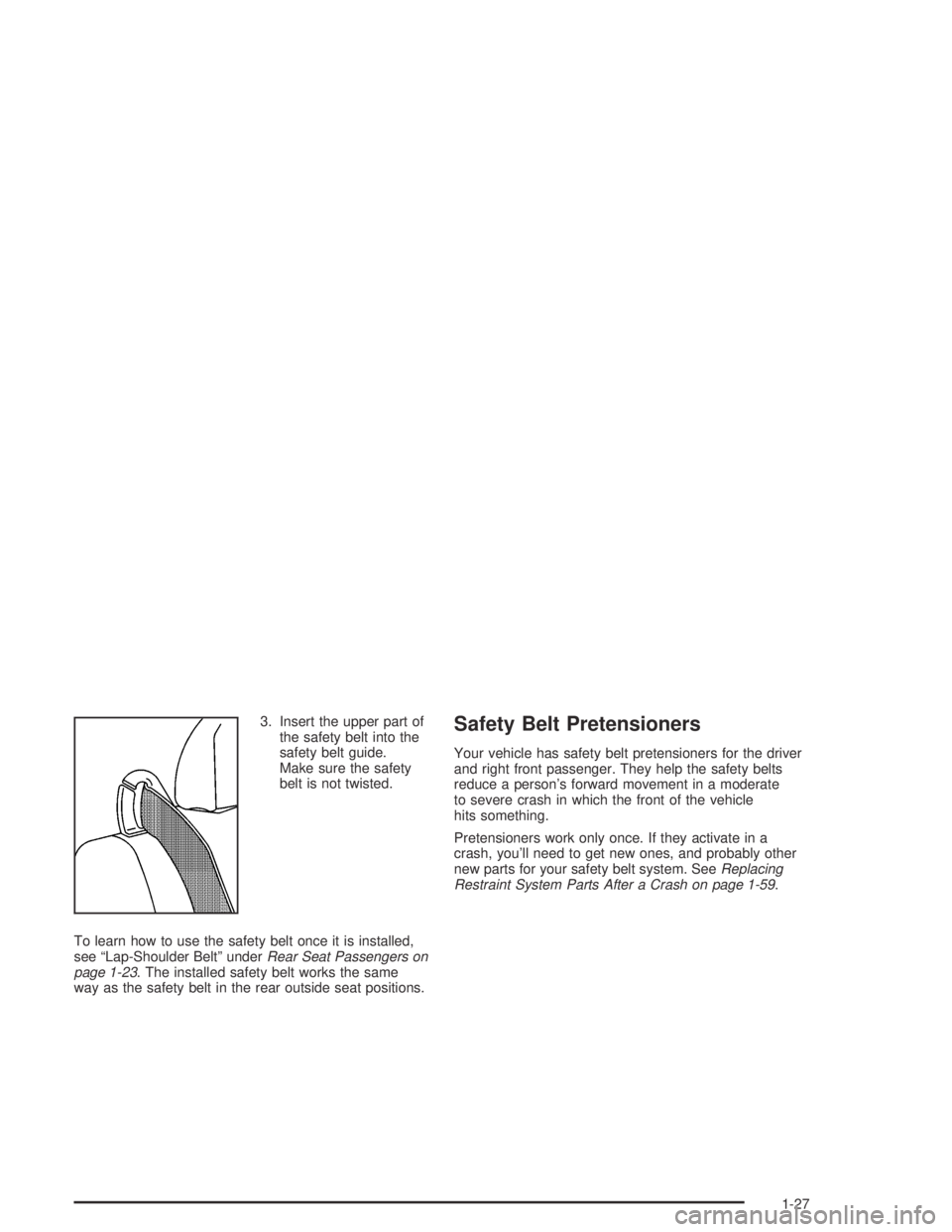
3. Insert the upper part of
the safety belt into the
safety belt guide.
Make sure the safety
belt is not twisted.
To learn how to use the safety belt once it is installed,
see “Lap-Shoulder Belt” underRear Seat Passengers on
page 1-23. The installed safety belt works the same
way as the safety belt in the rear outside seat positions.Safety Belt Pretensioners
Your vehicle has safety belt pretensioners for the driver
and right front passenger. They help the safety belts
reduce a person’s forward movement in a moderate
to severe crash in which the front of the vehicle
hits something.
Pretensioners work only once. If they activate in a
crash, you’ll need to get new ones, and probably other
new parts for your safety belt system. SeeReplacing
Restraint System Parts After a Crash on page 1-59.
1-27
Page 1477 of 5127
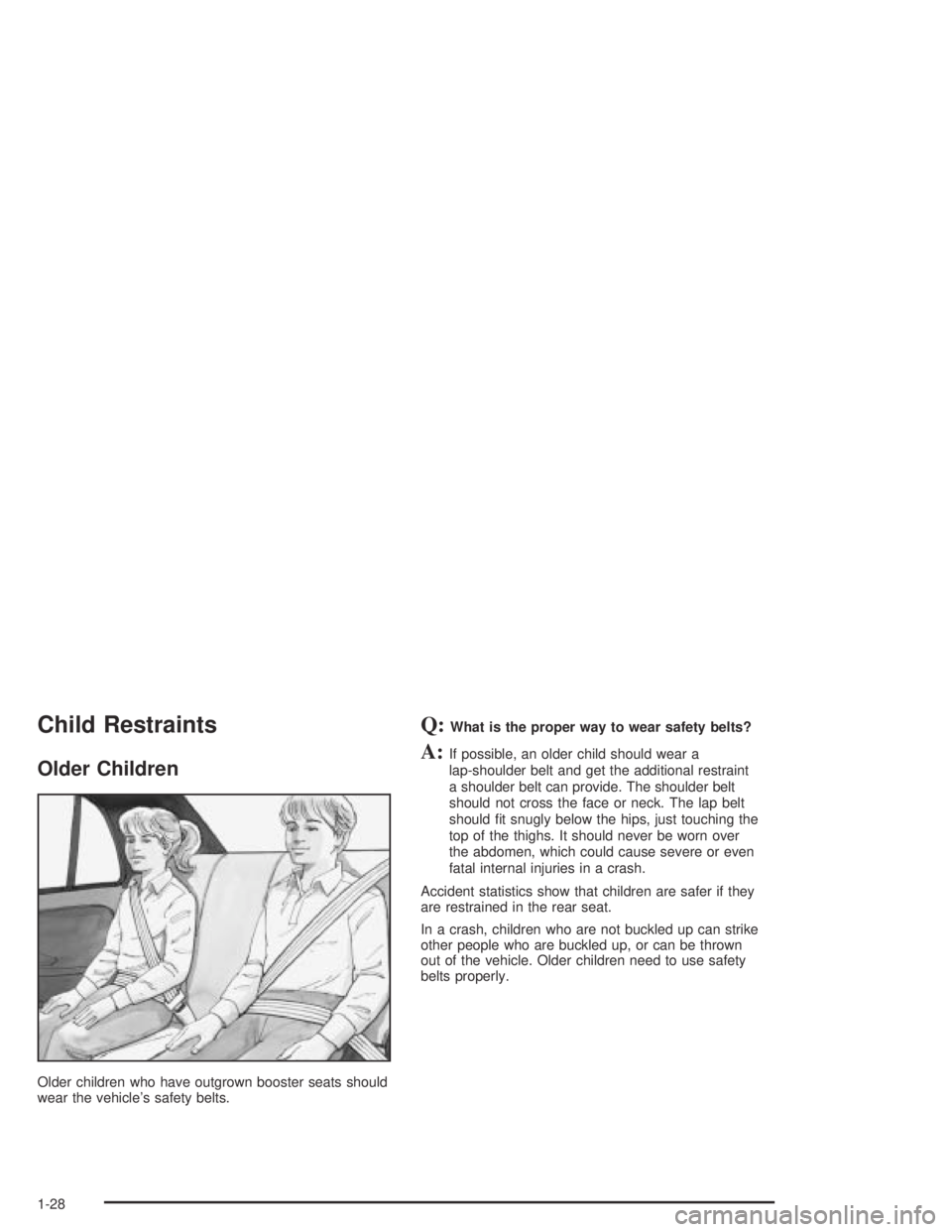
Child Restraints
Older Children
Older children who have outgrown booster seats should
wear the vehicle’s safety belts.
Q:What is the proper way to wear safety belts?
A:If possible, an older child should wear a
lap-shoulder belt and get the additional restraint
a shoulder belt can provide. The shoulder belt
should not cross the face or neck. The lap belt
should fit snugly below the hips, just touching the
top of the thighs. It should never be worn over
the abdomen, which could cause severe or even
fatal internal injuries in a crash.
Accident statistics show that children are safer if they
are restrained in the rear seat.
In a crash, children who are not buckled up can strike
other people who are buckled up, or can be thrown
out of the vehicle. Older children need to use safety
belts properly.
1-28
Page 1478 of 5127
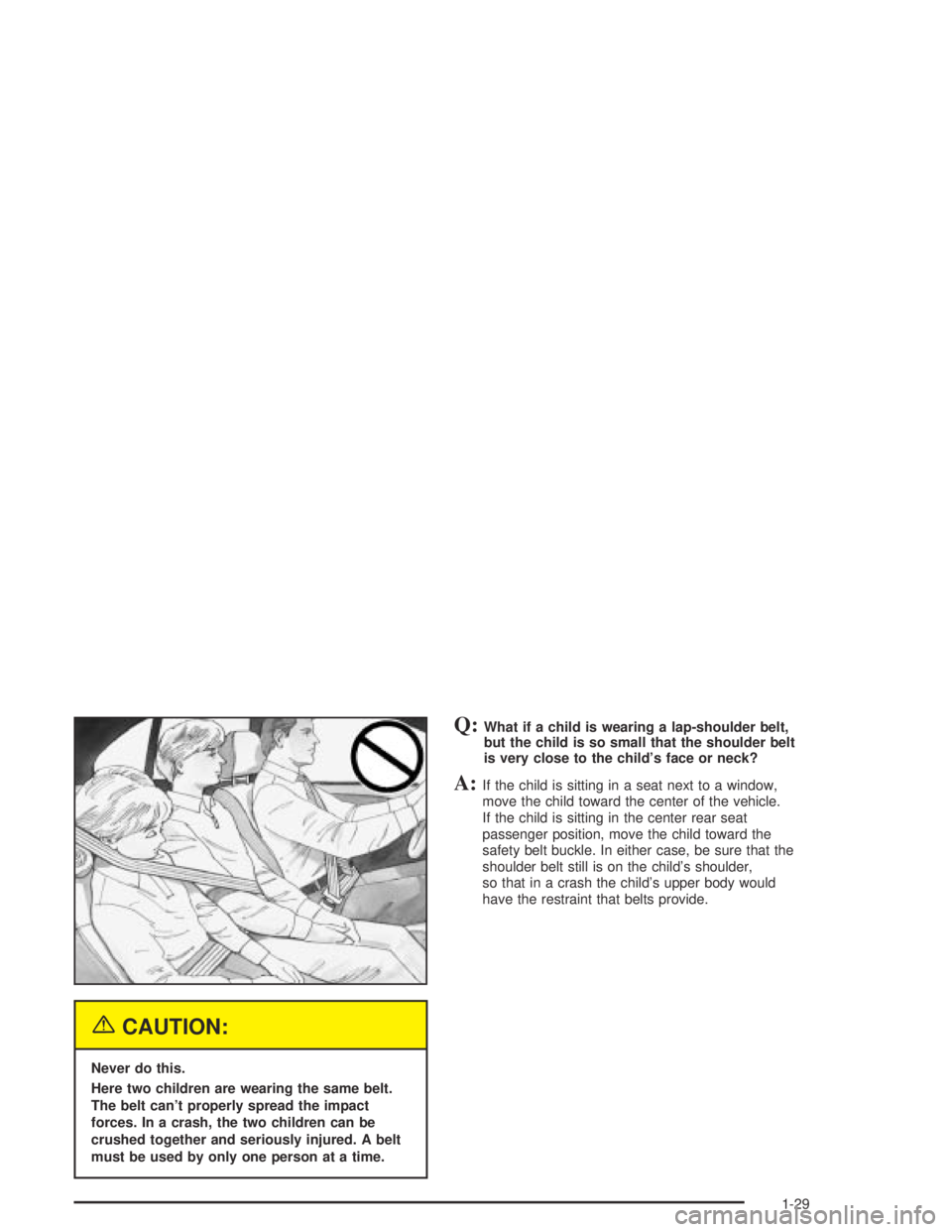
{CAUTION:
Never do this.
Here two children are wearing the same belt.
The belt can’t properly spread the impact
forces. In a crash, the two children can be
crushed together and seriously injured. A belt
must be used by only one person at a time.
Q:What if a child is wearing a lap-shoulder belt,
but the child is so small that the shoulder belt
is very close to the child’s face or neck?
A:If the child is sitting in a seat next to a window,
move the child toward the center of the vehicle.
If the child is sitting in the center rear seat
passenger position, move the child toward the
safety belt buckle. In either case, be sure that the
shoulder belt still is on the child’s shoulder,
so that in a crash the child’s upper body would
have the restraint that belts provide.
1-29
Page 1479 of 5127
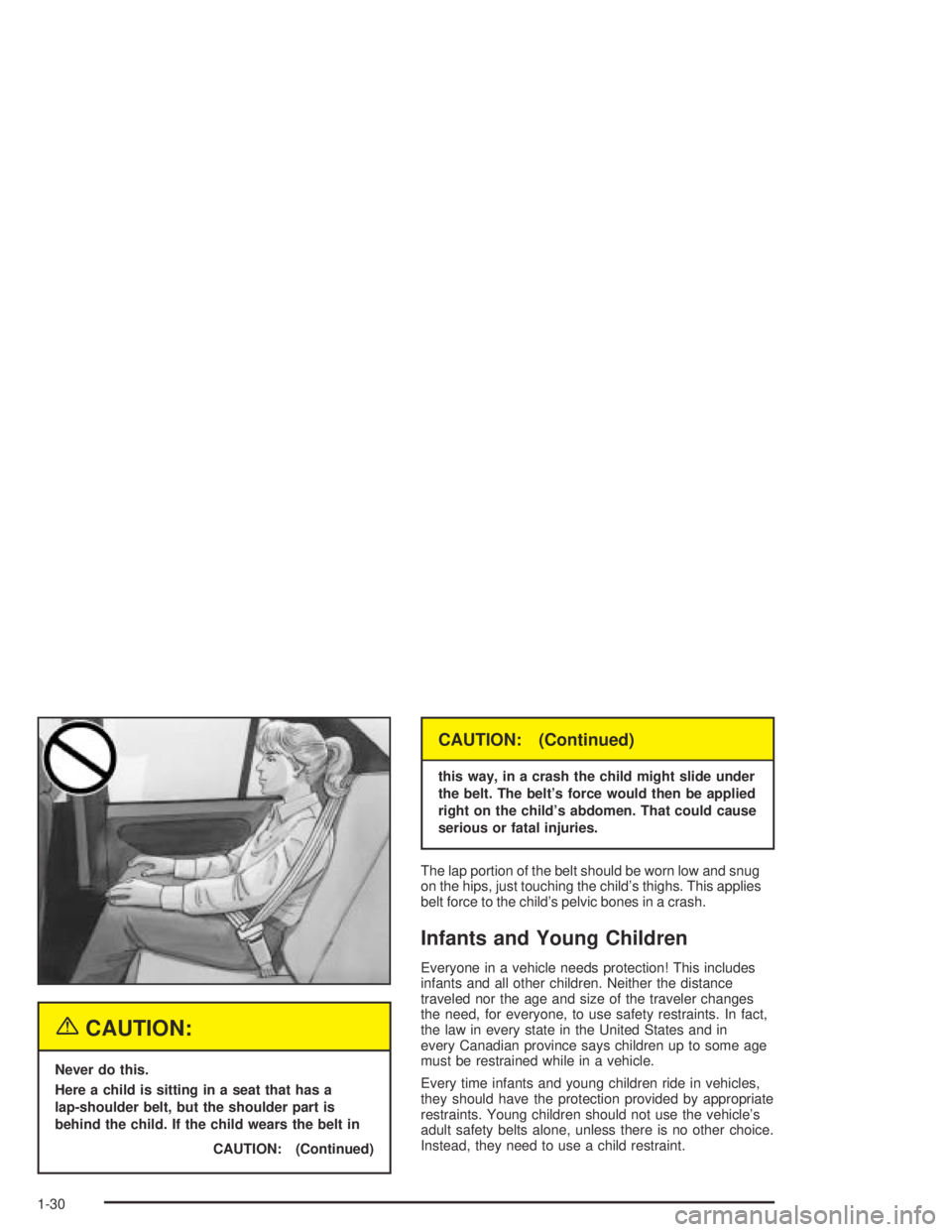
{CAUTION:
Never do this.
Here a child is sitting in a seat that has a
lap-shoulder belt, but the shoulder part is
behind the child. If the child wears the belt in
CAUTION: (Continued)
CAUTION: (Continued)
this way, in a crash the child might slide under
the belt. The belt’s force would then be applied
right on the child’s abdomen. That could cause
serious or fatal injuries.
The lap portion of the belt should be worn low and snug
on the hips, just touching the child’s thighs. This applies
belt force to the child’s pelvic bones in a crash.
Infants and Young Children
Everyone in a vehicle needs protection! This includes
infants and all other children. Neither the distance
traveled nor the age and size of the traveler changes
the need, for everyone, to use safety restraints. In fact,
the law in every state in the United States and in
every Canadian province says children up to some age
must be restrained while in a vehicle.
Every time infants and young children ride in vehicles,
they should have the protection provided by appropriate
restraints. Young children should not use the vehicle’s
adult safety belts alone, unless there is no other choice.
Instead, they need to use a child restraint.
1-30
Page 1480 of 5127
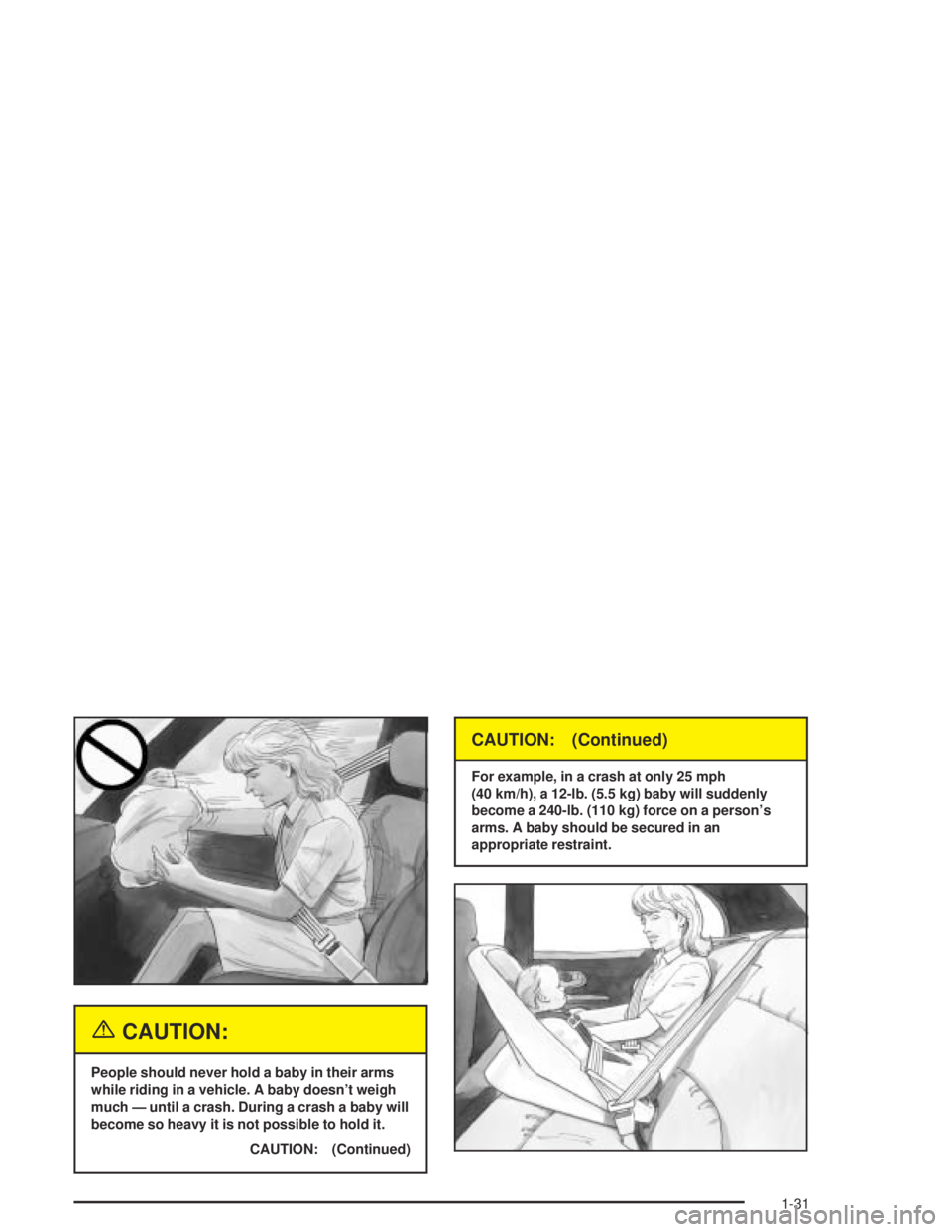
{CAUTION:
People should never hold a baby in their arms
while riding in a vehicle. A baby doesn’t weigh
much — until a crash. During a crash a baby will
become so heavy it is not possible to hold it.
CAUTION: (Continued)
CAUTION: (Continued)
For example, in a crash at only 25 mph
(40 km/h), a 12-lb. (5.5 kg) baby will suddenly
become a 240-lb. (110 kg) force on a person’s
arms. A baby should be secured in an
appropriate restraint.
1-31